Midterm Blogpost: Drift Management Strategies Benchmark
Evaluating approaches in tackling drifts
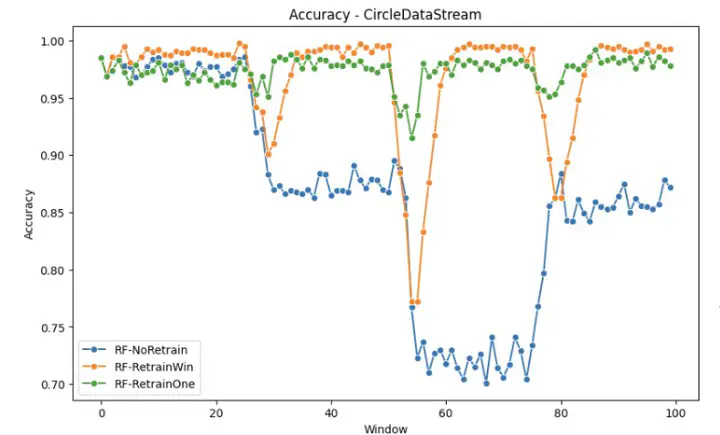
Hello there! I’m William and I’m thrilled to share the progress on my project, “Developing A Comprehensive Pipeline to Benchmark Drift Management Approaches” under the mentorship of Ray Andrew and Sandeep Madireddy under the LAST project.
Project Overview
If you’re not familiar with it, this project aims to address the issue of model aging, where machine learning (ML) models experience a decline in effectiveness over time due to environmental changes, known as drift. My goal is to design an extensible pipeline that evaluates and benchmarks the robustness of state-of-the-art algorithms in addressing these drifts.
Progress
So far, I’ve generated various synthetic datasets, which include:
- CIRCLE: This dataset contains two features x1, x2 drawn uniformly from the interval [0, 1]. Each data point is labeled as per the condition (x1 − c1)^2 + (x2 − c2)^2 <= r where the center (c1, c2) and radius r of the circular decision boundary changes gradually over a period of time introducing (gradual) concept drift.
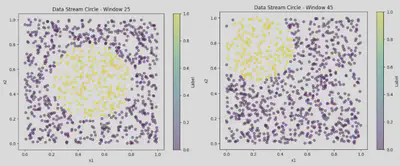
- COVCON: This 2-dimensional dataset has covariate shift and concept drift. The decision boundary at each point is given by α ∗ sin(πx1) > x2. We use 10000 points (100 batches, 1000 points per batch). Covariate shift is introduced by changing the location of x1 and x2 (for batch t x1 and x2). Concept drift is introduced by alternating the value of α.
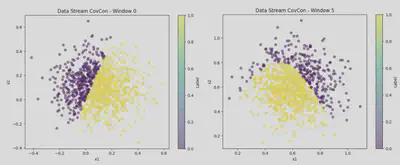
- SINE: This dataset contains two features x1, x2 drawn uniformly from the interval [0, 1]. In the first context all points below the curve y = sin(x) are classified as positive. The label for the classes are flipped after.
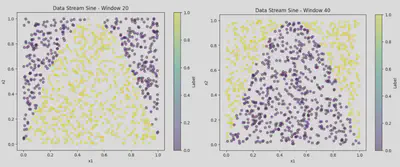
Additionally, I’ve also curated drifting data from the Tencent I/O block trace. These datasets will be used to benchmark model performance under different drift conditions.
The pipeline can receive a base sci-kit learn model, and evaluate their performance on these datasets prequentially. Here are some of the initial results for the performance of the models on these drifting dataset, under a never retraining and retraining, using 1 & 7 past windows. As you can see, model performance degrades upon encountering extreme drift.
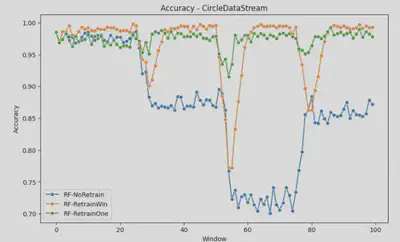
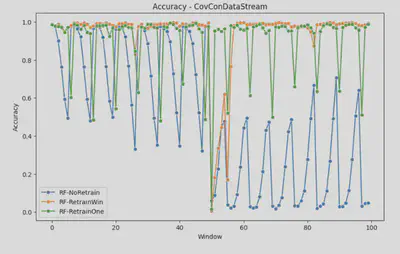

Findings
From the experiments conducted so far, the findings are as follows:
- A model without retraining struggles to maintain performance when drift occurs.
- Retraining on data from previous drifting windows, whether abruptly (SINE) or gradually (CIRCLE), leads to poorer performance, especially evident in the retrain Window, which incorporates data up to 7 windows prior.
- However, retraining on previous data proves beneficial in cases of covariate shift (CovCon), allowing the model to better align with the evolving real-world feature distributions.
Next Steps
As the base template for the pipeline and dataset curation is done, as I move forward, my focus will be on:
- Implementing three advanced algorithms: AUE (Accuracy Updated Ensemble), MATCHMAKER, and Driftsurf, then integrating them into the pipeline.
- Enhancing the benchmarking process by adding more metrics and plots, such as training time and inference time, to better evaluate the strategies.
- Packaging the entire experiment into a Chameleon Trovi Artifact, ensuring ease of reproducibility and extension.
Stay tuned for my final blog as I delve deeper into this project!